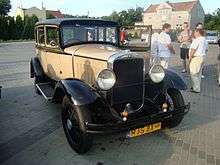Studebaker Dictator
The Studebaker Dictator is an automobile produced by the Studebaker Corporation of South Bend, Indiana (United States) from 1927-1937. Model year 1928 was the first full year of Dictator production.
.jpg)
In the mid-1920s, Studebaker began renaming its vehicles. The model previously known as the Studebaker Standard Six became the Dictator during the 1927 model year—internally designated model GE. The name was intended to connote that the model "dictated the standard" that other automobile makes would be obliged to follow.
The Dictator was Studebaker's lowest-price model, followed (in ascending order) by the Studebaker Commander and Studebaker President series. There was a Chancellor in 1927, too, but that year only.[1]:p239 In June 1929, Studebaker began offering an 8-cylinder engine for the Dictator series (221 cubic inches, 70 bhp at 3,200 rpm), designed by Barney Roos, though the old 6-cylinder option was continued for another year.[1]:p239 Dictators were available in a full range of body-styles.
Consequences of the Dictator name
In retrospect, the choice of the model name might seem unfortunate. One writer began a history of American perceptions of dictators[2] with the introduction of the Studebaker Dictator. He noted there were political problems in the name 'Dictator', making it unusable in European monarchies. The same applied in British Empire countries which imported the car. Diplomatically, Studebaker marketed its Standard Six as the Director in these countries.[3] In the United States the name initially caused no problems.[2]
At the time, the only dictator that would have immediately come to an American mind was Benito Mussolini, whose popular image was one of audacity and strength, in spite of well-publicized fascist violence.[2] However the rise of Adolf Hitler in Germany tainted the word 'dictator'. Studebaker abruptly discontinued the name 'Dictator' in 1937, resurrecting the Commander name which had been dropped in 1935. At that time, Raymond Loewy and Helen Dryden were working on new concepts for body design and customer appeal.
.jpg) 1927 Business Coupe |
 1927 4-door sedan |
 1927 4-door sedan |
.jpg) 1935 4-door sedan |
.jpg) 1936 2-door sedan |
.jpg) 1936 2-door sedan |
References
- Hendry, Maurice M. Studebaker: One can do a lot of remembering in South Bend. New Albany, Indiana: Automobile Quarterly. pp. 228–275. Vol X, 3rd Q, 1972.
- Alpers, Benjamin L. (2003). Dictators, Democracy, and American Public Culture: Envisioning the Totalitarian Enemy, 1920s-1950s. University of North Carolina Press. ISBN 0-8078-2750-9.
- Studebaker Director Victoria The Sunday Times (Western Australia), p. 23, 13 May 1928, at Trove
- Maloney, James H. (1994). Studebaker Cars. Crestline Books. ISBN 0-87938-884-6.
- Langworth, Richard (1979). Studebaker, the Postwar Years. Motorbooks International. ISBN 0-87938-058-6.
- Gunnell, John (1987). The Standard Catalog of American Cars 1946-1975. Krause Publications. ISBN 0-87341-096-3.